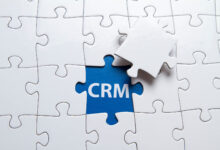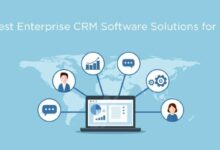CRM for Sales and Marketing Automation
CRM for Sales and Marketing Automation represents a powerful synergy, streamlining processes and boosting efficiency for both sales and marketing teams. By integrating these traditionally separate functions, businesses can achieve a more unified and data-driven approach to customer engagement, leading to improved lead generation, nurturing, and ultimately, higher conversion rates. This integration fosters better communication, collaboration, and a more holistic understanding of the customer journey.
This comprehensive guide explores the core functionalities of such a system, highlighting its key benefits and demonstrating how businesses can leverage its capabilities to optimize their sales and marketing efforts. We will delve into essential features, integration possibilities with other business tools, and crucial implementation considerations, providing practical insights for maximizing ROI.
Defining CRM for Sales and Marketing Automation
A Customer Relationship Management (CRM) system, when enhanced with marketing automation capabilities, becomes a powerful tool for streamlining sales and marketing processes. It centralizes customer data, automates repetitive tasks, and provides valuable insights for improved decision-making across both departments. This integrated approach fosters better collaboration and ultimately drives higher conversion rates and revenue growth.
Core Functionalities of a Sales and Marketing CRM
A comprehensive CRM system designed for both sales and marketing encompasses a wide array of functionalities. Core capabilities include contact management (centralized storage and organization of customer data), lead management (tracking and nurturing potential customers), sales pipeline management (visualizing and managing the sales process), marketing automation (automating email campaigns, social media posts, and other marketing activities), reporting and analytics (tracking key metrics and generating reports), and customer service features (managing customer inquiries and resolving issues). These functionalities work in concert to provide a holistic view of the customer journey.
Key Differences Between Sales-Only and Integrated CRMs
A CRM solely focused on sales typically manages contacts, deals, and sales processes. It might include features for tracking opportunities, managing sales teams, and generating sales reports. However, it lacks the integrated marketing automation tools found in a combined CRM. An integrated CRM, on the other hand, adds capabilities like automated email marketing, lead scoring, campaign management, and marketing analytics. This integration allows for seamless handoff of leads from marketing to sales, improving lead qualification and nurturing. The key difference lies in the ability to orchestrate and track the entire customer journey, from initial contact to post-sale engagement, within a single system.
Examples of Leveraging a Combined CRM for Improved Efficiency
Imagine a scenario where a marketing team uses the CRM to segment customers based on their behavior and preferences. They then launch a targeted email campaign promoting a new product. The CRM automatically tracks open rates, click-through rates, and other engagement metrics. Leads who show strong engagement are automatically scored higher and routed to the sales team. Sales representatives receive detailed information about each lead, allowing them to personalize their outreach and improve conversion rates. Conversely, sales data on successful deals can inform future marketing campaigns, creating a continuous feedback loop for optimization. This integrated approach ensures that marketing efforts directly contribute to sales success, and vice-versa. Another example involves automated follow-up emails after a sales call or purchase, nurturing the relationship and fostering customer loyalty.
Comparison of CRM Systems for Sales and Marketing Automation
| Feature | CRM A (e.g., HubSpot) | CRM B (e.g., Salesforce Sales Cloud) | CRM C (e.g., Zoho CRM) |
|---|---|---|---|
| Marketing Automation | Extensive features, including email marketing, lead scoring, and campaign management | Strong capabilities, often requiring integration with other marketing automation platforms | Good range of features, suitable for mid-sized businesses |
| Sales Pipeline Management | Visual dashboards and reporting for tracking sales progress | Highly customizable and scalable pipeline management tools | User-friendly interface with customizable sales stages |
| Contact Management | Robust contact management with segmentation and personalization features | Comprehensive contact management with advanced filtering and search capabilities | Solid contact management, integrates well with other Zoho applications |
| Reporting and Analytics | Detailed reporting and analytics across sales and marketing activities | Powerful reporting and analytics tools, customizable dashboards | Provides key metrics and reports for tracking performance |
| Pricing | Tiered pricing model, suitable for various business sizes | Typically more expensive, suitable for larger enterprises | Offers competitive pricing, attractive for budget-conscious businesses |
Benefits of Integrated Sales and Marketing Automation
Integrating sales and marketing automation through a unified CRM system offers significant advantages, streamlining processes and boosting overall efficiency. A cohesive system fosters better collaboration, improved data insights, and ultimately, increased revenue. This section explores the key benefits of this integration, providing illustrative examples to highlight its impact.
Case Studies Illustrating Improved Sales Performance
The power of a unified CRM is best demonstrated through real-world examples. Here are three case studies showcasing the positive impact on sales performance:
- Company A: A mid-sized SaaS company implemented a CRM with integrated marketing automation. By automating lead qualification and assignment, they reduced sales cycle length by 20%, resulting in a 15% increase in closed-won deals within six months. This improvement stemmed from sales reps focusing on qualified leads and having access to a centralized repository of customer information.
- Company B: A B2B manufacturing firm experienced a significant boost in sales productivity. Their integrated CRM provided real-time visibility into customer interactions across marketing and sales. This enabled them to personalize communication and tailor their sales approach, leading to a 25% increase in sales conversion rates within a year. The key here was the elimination of information silos and the ability to provide a consistent customer experience.
- Company C: A retail company leveraged integrated CRM data to improve customer segmentation and targeting. This resulted in more effective marketing campaigns and better lead generation. They saw a 30% increase in qualified leads within nine months, which directly translated to a 12% increase in revenue. The precise targeting and personalized messaging were key factors in this success.
Impact of Marketing Automation on Lead Nurturing and Conversion
Marketing automation features embedded within a CRM significantly enhance lead nurturing and conversion rates. Automated email sequences, personalized content delivery, and targeted advertising campaigns, all managed within a single platform, contribute to improved lead qualification and engagement. This leads to a more efficient use of sales resources and a higher likelihood of converting leads into paying customers. For instance, automated email nurturing campaigns can deliver timely information and offers based on lead behavior, significantly increasing engagement and ultimately, conversion.
Improved Data Visibility and Reporting for Sales and Marketing
A unified CRM system provides both sales and marketing teams with a 360-degree view of customer data. This improved data visibility enables data-driven decision-making, allowing for more effective strategy adjustments. Comprehensive reporting capabilities offer insights into campaign performance, sales pipeline health, and customer behavior. This shared understanding eliminates guesswork, fostering better collaboration and accountability across departments. For example, marketing can see which campaigns are generating the most qualified leads, while sales can track the performance of individual reps and identify areas for improvement. This shared data transparency fosters a more efficient and collaborative environment.
Visual Representation of Workflow Improvements
The following describes a visual representation illustrating the streamlined workflow from lead generation to sales closure with an integrated CRM.
Imagine a flowchart. The process begins with a “Lead Generation” box, representing various marketing activities (e.g., website forms, social media ads, email campaigns). Arrows lead from this box to a “Lead Qualification” box, where automated scoring and routing based on predefined criteria occur within the CRM. Qualified leads then flow into a “Lead Nurturing” box, depicting automated email sequences and personalized content delivery. Following nurturing, leads progress to a “Sales Engagement” box, where sales representatives utilize the CRM’s tools to manage interactions, track progress, and close deals. Finally, an arrow leads to a “Sales Closure” box, followed by a “Customer Onboarding” box, highlighting the seamless transition to post-sales processes, all managed within the unified CRM system. Each box would be visually connected by arrows representing the flow of leads and information, showcasing the seamless integration and automation of the entire process. The entire flowchart is contained within a larger box labeled “Integrated CRM System,” emphasizing the central role of the system in orchestrating the entire sales and marketing process.
Key Features of a Robust CRM for Sales and Marketing
A robust CRM system is the backbone of any successful sales and marketing operation. It’s more than just a contact list; it’s a centralized hub for managing interactions, automating processes, and gaining valuable insights into customer behavior. Choosing the right CRM with the right features is critical for maximizing its potential.
This section will delve into five essential features of a robust CRM, explore the differences between cloud-based and on-premise solutions, and categorize CRM features for clarity. We will also demonstrate how powerful marketing automation tools within a CRM can enhance customer segmentation and personalized messaging.
Five Essential CRM Features for Sales and Marketing Automation
Several features are crucial for effective sales and marketing automation. The absence of these core functionalities can significantly hinder a company’s ability to optimize its processes and achieve its marketing goals. These features work in synergy to provide a comprehensive view of the customer journey and facilitate efficient interaction across all touchpoints.
- Contact Management: A robust contact management system allows for detailed profiling of leads and customers, including contact information, interaction history, and purchase history. This detailed information enables targeted marketing and personalized communication.
- Lead Management and Scoring: This feature helps prioritize leads based on their likelihood to convert. Lead scoring assigns points based on various factors (e.g., website activity, email engagement, demo requests), enabling sales teams to focus on high-potential prospects.
- Sales Pipeline Management: Visualizing the sales process allows for efficient tracking of deals at each stage, from initial contact to closing. This provides valuable insights into sales performance and helps identify bottlenecks.
- Marketing Automation: This encompasses features like email marketing, automated workflows, and campaign tracking. Automation streamlines repetitive tasks, improves efficiency, and allows for personalized messaging based on customer segmentation.
- Reporting and Analytics: Comprehensive reporting and analytics provide insights into sales performance, marketing campaign effectiveness, and customer behavior. Data-driven decision-making becomes possible through detailed analysis of key metrics.
Cloud-Based versus On-Premise CRM Solutions
The choice between cloud-based and on-premise CRM solutions depends on various factors, including budget, IT infrastructure, and company size. Both offer distinct advantages and disadvantages.
| Feature | Cloud-Based CRM | On-Premise CRM |
|---|---|---|
| Cost | Typically lower upfront costs, subscription-based | Higher upfront costs, ongoing maintenance expenses |
| Accessibility | Accessible from anywhere with an internet connection | Accessible only within the company’s network |
| Scalability | Easily scalable to accommodate growth | Requires significant investment to scale |
| Maintenance | Vendor handles maintenance and updates | Company responsible for maintenance and updates |
| Security | Vendor responsible for data security, subject to vendor’s security protocols | Company responsible for data security, requires robust internal security measures |
Categorization of CRM Features
Organizing CRM features into logical categories helps understand their functionalities and how they contribute to overall business goals. This structured approach simplifies the process of identifying and utilizing the most relevant features for specific tasks.
- Lead Management: Lead capture, scoring, qualification, and nurturing.
- Sales Pipeline Management: Opportunity tracking, deal progression, forecasting, and sales reporting.
- Marketing Campaign Management: Campaign planning, execution, automation, and performance analysis.
- Reporting and Analytics: Sales performance dashboards, marketing campaign ROI, customer behavior analysis, and predictive modeling.
- Customer Service Management: Ticket management, case resolution, customer interaction tracking, and feedback analysis.
Customer Segmentation and Personalized Messaging
CRM systems, particularly those with robust marketing automation capabilities, facilitate effective customer segmentation and personalized messaging. This targeted approach significantly improves marketing campaign effectiveness and customer engagement.
For example, a company could segment its customer base based on demographics (age, location, gender), purchase history (frequency, value, product type), or website behavior (pages visited, time spent on site). Once segmented, personalized email campaigns, targeted advertising, and customized website content can be deployed to each segment. A company selling outdoor gear might segment customers into hikers, campers, and climbers, then send each group tailored email newsletters featuring relevant products and promotions. This targeted approach maximizes engagement and conversion rates compared to a generic marketing campaign.
Integration with Other Business Tools
A robust CRM for sales and marketing automation isn’t a standalone system; its true power lies in its ability to seamlessly integrate with other essential business tools. This interconnectedness streamlines workflows, improves data accuracy, and ultimately boosts efficiency and ROI. Effective integration allows for a holistic view of customer interactions across multiple platforms, leading to more informed decision-making and personalized customer experiences.
CRM Integration with Email Marketing Platforms
Integrating your CRM with an email marketing platform like Mailchimp, Constant Contact, or HubSpot allows for highly targeted and personalized email campaigns. The CRM provides real-time data on customer behavior, preferences, and purchase history, which the email platform then uses to segment audiences and deliver relevant content. This ensures that marketing messages are not only timely but also resonate with individual customer needs, improving open rates, click-through rates, and ultimately conversion rates. For instance, a customer who recently viewed a specific product on your website might receive a targeted email promoting that product with a special offer. This level of personalization significantly enhances customer engagement and drives sales.
Benefits of Integrating CRM with Social Media Management Tools
Integrating your CRM with social media management tools like Hootsuite or Buffer allows for a unified view of customer interactions across various social media channels. This means sales and marketing teams can monitor brand mentions, respond to customer inquiries, and track social media campaigns directly within the CRM. This integration facilitates a more responsive and personalized customer experience, improves brand reputation management, and provides valuable data for refining marketing strategies. For example, tracking social media engagement with specific marketing campaigns directly within the CRM allows for a more precise understanding of campaign performance and ROI.
Enhancing Sales Productivity with CRM Integration and Sales Intelligence Platforms
Integrating your CRM with sales intelligence platforms like ZoomInfo or LinkedIn Sales Navigator provides sales teams with access to rich customer data and insights. This data can include contact information, company details, social media activity, and sales history. This information empowers sales representatives to personalize their outreach, prioritize leads, and tailor their sales pitches for maximum impact. For example, a sales representative could use sales intelligence data to identify key decision-makers within a target account, leading to more effective and efficient sales conversations. The ability to quickly access this information within the CRM saves valuable time and resources, ultimately increasing sales productivity.
Data Flow Between CRM and Other Business Tools
The following flowchart illustrates the typical data flow between a CRM and other key business tools:
[Diagram description: A flowchart showing data flowing from a CRM to a Marketing Automation Platform (MAP), an Email Marketing Platform (EMP), and a Sales Intelligence Platform (SIP). Each platform then sends data back to the CRM. A separate arrow indicates data flowing from all three platforms into an Analytics Dashboard. The CRM acts as the central hub, receiving and distributing data between all other systems. The arrows show the direction of data flow, indicating a two-way communication between the CRM and the other platforms. The Analytics Dashboard receives data from all systems to provide a holistic view of marketing and sales performance.]
Implementation and Training Considerations
Implementing a new CRM system, while offering significant benefits, presents several challenges. Successfully navigating these challenges requires careful planning, resource allocation, and a commitment to comprehensive training and user adoption. Ignoring these aspects can lead to low user engagement, inaccurate data, and ultimately, a failed CRM implementation. The key to success lies in proactive mitigation of potential hurdles and a focus on empowering users to effectively leverage the system’s capabilities.
Successful CRM implementation hinges on effective training and user adoption. Resistance to change, lack of understanding of the system’s functionalities, and insufficient support can all hinder a smooth transition. A well-structured training program is crucial for overcoming these obstacles and ensuring that users are confident and proficient in utilizing the CRM for their daily tasks. This, in turn, maximizes the return on investment and ensures the CRM achieves its intended purpose of streamlining sales and marketing processes.
Data Migration Strategies
Migrating data from legacy systems to a new CRM can be a complex process. Inaccurate or incomplete data can significantly impact the system’s effectiveness and lead to poor decision-making. A phased approach, involving thorough data cleansing and validation before migration, is recommended. This ensures data integrity and minimizes disruption to ongoing operations. For instance, a company might start by migrating customer data from one department, thoroughly testing the migrated data and addressing any issues before moving on to other departments’ data. This allows for iterative improvements and minimizes the risk of widespread errors. Robust data mapping is essential to ensure accurate transfer of information between systems, and regular data quality checks post-migration are necessary to maintain data accuracy and reliability.
Sales and Marketing Team Training Program
A comprehensive training program is essential for effective CRM utilization. The program should be tailored to the specific needs and roles of sales and marketing teams, ensuring that each user receives training relevant to their responsibilities. The program should also incorporate ongoing support and resources to address any questions or challenges that arise after the initial training.
- Module 1: Introduction to the CRM System: Overview of the CRM system’s functionalities and its benefits for sales and marketing teams. This module would cover basic navigation, logging in and out, and understanding the user interface.
- Module 2: Contact Management: Detailed explanation of how to add, edit, and manage contacts within the CRM, including utilizing the system’s search and filtering capabilities.
- Module 3: Lead Management and Qualification: This module would cover lead generation, tracking, qualification, and assignment within the CRM. It would also demonstrate the use of lead scoring and automation tools.
- Module 4: Sales Pipeline Management: This module would focus on visualizing and managing the sales pipeline, tracking opportunities, and forecasting sales performance. It would also cover the use of reporting and analytics features.
- Module 5: Marketing Automation: This module would cover creating and managing marketing campaigns, tracking campaign performance, and integrating marketing automation tools with the CRM. It would include hands-on exercises in email marketing and social media integration.
- Module 6: Reporting and Analytics: This module would focus on utilizing the CRM’s reporting and analytics tools to track key performance indicators (KPIs), gain insights into sales and marketing performance, and make data-driven decisions.
- Module 7: Advanced Features and Customization: This module would cover advanced features such as workflow automation, custom fields, and integrations with other business tools. It would also cover the process for requesting custom features or modifications to the system.
- Module 8: Ongoing Support and Troubleshooting: This module would provide information on available support channels, including FAQs, documentation, and contact information for technical support.
Concluding Remarks
Implementing a CRM for sales and marketing automation offers significant advantages for businesses seeking to improve efficiency and drive growth. From enhanced lead nurturing and improved data visibility to streamlined workflows and stronger customer relationships, the benefits are multifaceted and demonstrably impactful. By carefully considering the key features, integration options, and implementation strategies outlined in this guide, organizations can effectively harness the power of a unified CRM to achieve their sales and marketing objectives and ultimately gain a competitive edge in today’s dynamic marketplace.




